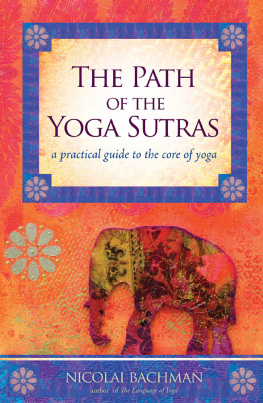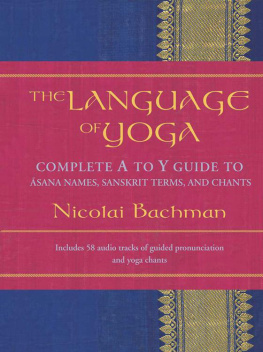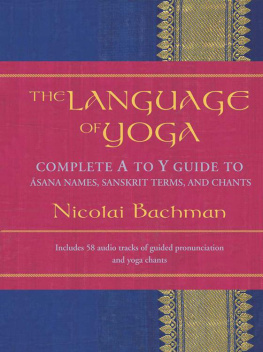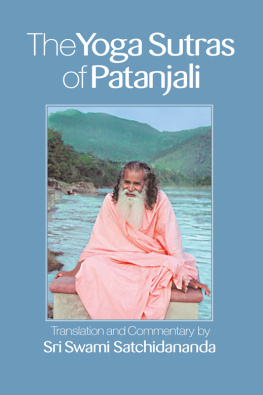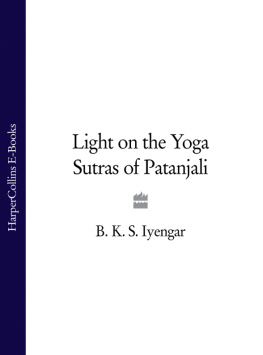
To all teachers who have shared their wisdom and experience, who have walked their talk, and who have quietly opened our hearts and minds to the pure inner spirit residing within each of us. Prama! (Respectful blessings to you!)
Out beyond ideas of wrongdoing and rightdoing, there is a field. Ill meet you there.
RUMI, from SOUL, HEART, AND BODY ONE MORNING
CONTENTS
FOREWORD
AT THE OUTSET OF MY training as an early twenty-something, I was eager, enthusiastic, and passionate for the discipline of yoga. After a trip to India in 1989, my curiosity accelerated, yet I was uncertain about how to connect to the greater yoga tradition in a more in-depth and sustained way. It was not until I was introduced to the Sanskrit language with Nicolai Bachman that I found a foothold in the long, and at times sheer, climb up the yoga mountain. Blessed to find Nicolai as a teacher, I came to see how the yoga experience is intimately connected to sound and vibration. Not only is Sanskrit the source of the vast and subtle knowledge pertaining to yoga, but it relates to the direct experience within yoga, whether through memorization of a stra, the intonation of mantra, or the vibration that pulses through the bodys energy channels (n-s) in yoga postures. As I continue to study with Nicolai today, it is not just the mechanics of Sanskrit that he elucidates, but the mystical and energetic associations pertaining to the language.
The Yoga Stras of Patajali are built on the Sanskrit language, and in many respects they are the bedrock for yoga training. In this book, Nicolai does a great service of unpacking the weight of the Sanskrit so that traveling the terrain of the Yoga Stras is clear and easy to follow.
Over the years, Nicolai and I have deciphered the stra-s together on long treks in the mountains of northern New Mexicohe parsing out the vocabulary and meaning, while I contributed my experience on the mat and on the meditation cushion. Given that the yogic journey is in many respects a solitary one, it has been a unique and invaluable opportunity for me to share an investigation into the yoga teachings with my colleague and friend Nicolai.
Inspired by Nicolaiand through my own investigations into the roots of the yoga teachingsit has become clear to me that a dedicated yoga practice must not be limited to the execution of physical postures and should involve a close investigation of activity within the mind-heart. It is ironic that, today, yoga has become identified with flexible hamstrings and abdominal lifts, for historically it has involved careful and extensive analysis of thought, feeling, attitude, and point of view.
At the heart of yoga practice is inquiry. In order for human beings to transform in positive ways involving mind, body, and emotion, there must be some critical means of self-reflection. In the following chapters, Nicolai unravels the stra-s, not only from his vantage point of the Sanskrit language, but from the depths of his own study, inquiry, and practice.
The Yoga Stras of Patajali is a gateway into the realm of inquiry, and for the committed yoga student it offers a vocabulary to begin to see into patterns of emotional and psychological holding. The stra-s are threadsand sometimes but strands of threadthat require a guide or coach to help unravel them due to the terse, minimalist style in which they are rendered. In the pages ahead, Nicolai takes some of the complex and difficult-to-grasp themes within the stra-s and renders them more accessible. The stra-s are not intentionally cryptic or out of reach in the way that koans are in the Chinese and Japanese traditions. In keeping with the greater stra tradition, Patajalis Yoga Stras invite commentary. Like a Rubiks Cube, the stra-s are meant to be turned over, examined, tested, and aligned until the practitioner realizes the complete mandala of the Cube.
So inquiry or investigative self-reflection is the basis for yogic maturation and ultimately the means to self-knowledge. If a yoga practice is devoid of inquiry into the nature of mind or devoid of real self-reflection, is it really yoga?
In guiding us through the stra-s, Nicolai takes the overall grid of the stra-s and elucidates the most integral and elemental patterns within the text. This is extremely helpful, for the Yoga Stras of Patajali are wide in scope and include an array of different means to the direct experience of yoga. The teaching within each stra connects to the field of the other stra-s. It is this way in the body as well. That is, the shoulder blade is connected to the sacrum via connective tissue, and the tongue has ligamentous and energetic connections to the respiratory diaphragm. I like to think of the stra-s as a field, like an electromagnetic field, and each verse connects to the verse that precedes and follows it, and also to other verses within the field. This is why the thematic groupings of the concepts offered in the following chapters, such as karma, suffering, practice, restraint, and meditation give us clues about how to find our way into the mandala of the stra-s and to understand their essential patterns.
It is possible to approach Patajalis stra-s as a philosophical puzzle that must be interpreted and understood intellectually. And while the text is heuristic (in keeping with the rich and vibrant yoga tradition that involved extensive debate, reasoning, and logic), it is also meant to be a practical guide for personal transformation. Rather than exercises in mental abstraction however, the stra-s, if they are to be effective stratagems for change, must be actualized and lived. It is in this spirit that this book renders the verses of the Yoga Stras. Nicolai breathes life into the teachings, and through a candid, clear-eyed approach, he makes the principles within the text applicable and workable in everyday life.
On our long walks in the Sangre de Cristo Mountains outside of Santa Fe, Nicolai and I have explored the heart of the yoga teachings. In the way that a turn on the trail offers a new vista, our dialogues attempt to view the teachings from as many points of view as possible. Trekking on a path, be it a mountain path or a spiritual path, is made possible by those travelers who precede us. Once the path is cleared of tangled overgrowth and debris, it is easier to make progress. The stra-s of Patajali do just this. By elucidating the hazards of emotional and psychological clinging, they allow for passage on the path of yoga, thus clearing the way toward spiritual fulfillment. The journey is profoundly an inward one. Patajali guides one on a pilgrimage through the jungles of distraction and confusion in the heart-mind to the inner sanctum of the seer or witness.
As a friend and colleague, I know Nicolais greatest asset to be his capacity to discriminateclearly, objectively, and lovingly. This capacity for discernment is central to the teachings of Patajali. In the Yoga Stras, the instrument to freeing the mind, body, and spirit is discriminating awareness. The sword of discrimination is used to disentangle the pure witness from the everyday perceiver with its mixed bag of perceptions, mental chatter, dreams, and habitual psychological tendencies.
To make progress on the path, the yogi must have the sword of discrimination held up high, with a readiness to cut through. The Yoga Stras inspire practitioners to keep their blade of discriminatory awareness sharp. The edge inevitably grows dull. Today there is greater opportunity for self-indulgence and interconnectedness alike, given the onslaught of the digital age and the influence of the media where youth and adults alike whittle away their time on cellular devices and broadband networks. Those dedicated to the path of yoga through practice and engaged insight must daily sharpen their blade. The yogi and yogini hone the sword of good judgment via the whetstone of the breath, the precision and flow of the yoga posture, the subtle adjustments of the diaphragm and respiratory muscles in
Next page
